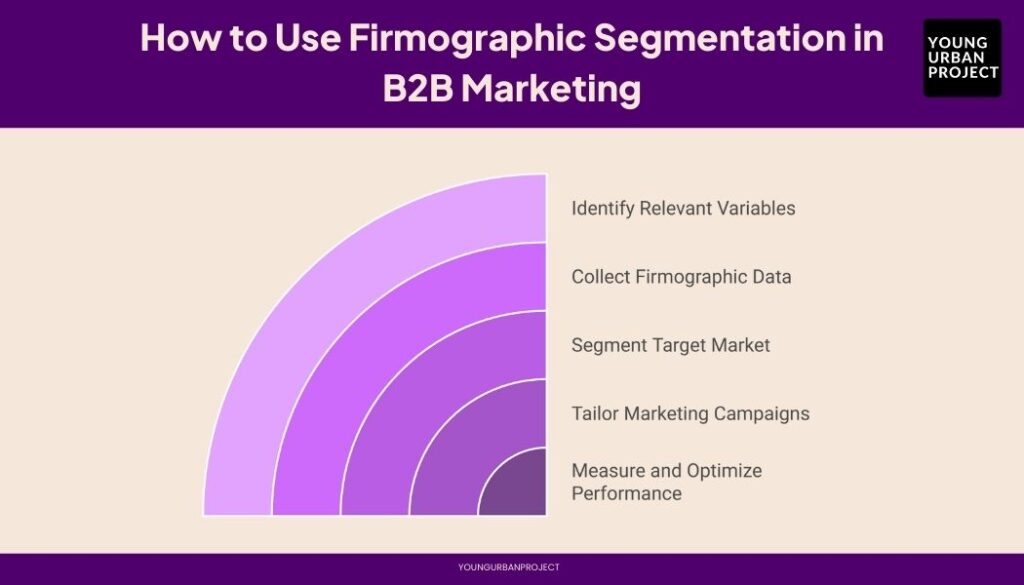When it comes to B2B marketing, targeting the right companies is just as important as targeting the right individuals. But how can businesses effectively identify and group organizations with similar needs and traits? The answer lies in firmographic segmentation.
Table of Contents
This guide will explain what is firmographic segmentation, why it’s essential for B2B marketing, and how you can start implementing it to drive your success. Whether you’re a marketing manager, sales professional, or a B2B marketer, by the end of this blog, you’ll have practical insights to refine your targeting strategies.
What Is Firmographic Segmentation?
Firmographic segmentation groups companies based on shared characteristics, much like how demographic segmentation classifies individuals in B2C marketing. It focuses on the traits of the company itself, such as size, industry, revenue, location, and decision-maker roles. This allows marketers and sales teams to tailor campaigns and outreach to address the unique needs of different business segments.
Also Read: What is Segmentation in Marketing and its Types?
Why Does Firmographic Segmentation Matter in B2B Marketing?
Unlike B2C, where emotions and behaviors often drive decisions, B2B transactions are typically more complex, involving longer decision cycles and multiple stakeholders. Firmographic segmentation helps cut through this complexity by enabling businesses to:
- Tailor messaging and campaigns based on real company traits.
- Identify high-value targets more effectively.
- Optimize marketing and sales resources by focusing on prospects with the highest potential ROI.
- Better align marketing strategies with business objectives.
Firmographic Segmentation vs. Demographic & Geographic Segmentation
At a glance, segmentation may seem universal, but the audiences and objectives differ significantly between firmographic, demographic, and geographic segmentation.
Key Differences in Audience (B2B vs. B2C)
Understanding the difference between B2B and B2C audiences is essential for effective segmentation. B2C (Business-to-Consumer) strategies use demographic and geographic data to target individuals based on personal traits and locations. In contrast, B2B (Business-to-Business) marketing relies on firmographic segmentation, focusing on company size, industry, and revenue to tailor messaging for other businesses.
1. Demographic Segmentation
Companies split people into groups based on things like age, money, and jobs. This works great for selling stuff to regular folks. Fancy brands target rich people, while toy makers focus on families with kids. This helps businesses talk directly to the right customers.
2. Firmographic Segmentation
When selling to businesses, companies group them by size, industry, and money made. This helps tailor sales pitches to different company types. A software company might focus on medium-sized tech businesses or new companies that make certain amounts of money each year.
3. Geographic Segmentation
Location matters in marketing. Companies target specific places like countries, cities, or neighborhoods. Weather can also matter. Winter coat sellers focus on cold areas, while local repair shops target nearby neighborhoods. This works for both people and business customers.
When to Use Firmographic Segmentation
Use firmographic segmentation when selling to businesses, not individuals. Focus on company traits like industry and size. This works when your offers differ for startups versus big companies. New companies want affordable, growth-friendly solutions, while bigger firms need efficiency and tools that work with existing systems.
Integrating Segmentation Strategies
Don’t rely only on firmographic segmentation. Combine it with other methods like behavior patterns, technology usage, and company values. This complete approach gives you a better picture of your business customers, helping you create more effective marketing campaigns that truly speak to their needs.
Also Read: 12 Types of market segmentation and how to select one
Key Variables in Firmographic Segmentation
1. Industry and Company Size
Different industries need different approaches because they face unique challenges. A healthcare software startup worries about privacy rules, while big manufacturing companies focus on supply chain efficiency. Tailor your message to match what matters most to each industry type.
2. Annual Revenue and Performance
A company’s yearly income shows what they can afford to buy. Group businesses by how much money they make to match your pricing strategy. Rich companies might pay for premium options, while smaller businesses need budget-friendly choices. Adjust your sales pitch accordingly.
3. Location
Where a company operates affects their needs, preferences, and which laws they follow. City-based businesses might want faster delivery than rural companies. Different countries have different regulations. Consider these geographic factors when targeting business customers with your marketing messages.
4. Stage in Sales Cycle
Match your approach to where companies are in buying decisions. Early-stage prospects need educational content to build awareness. Those comparing options need case studies and comparisons. Ready-to-buy companies respond to messages about urgent value and easy implementation.
5. Company Status and Age
New startups, medium businesses, and large corporations have different needs. Startups want innovation but have tight budgets. Medium companies seek efficiency advantages. Big enterprises need solutions that handle complexity and work worldwide. Target each group differently.
6. Job Titles and Decision Roles
Know who makes buying decisions. Top executives care about investment returns and strategy. Department heads focus on how products help their teams. Create messages that speak to both strategic and practical concerns to address everyone involved in the purchase decision.
How to Use Firmographic Segmentation in B2B Marketing

Step 1: Identify Relevant Variables
Look at your product and decide which company details matter most. Maybe it’s company size, industry type, or yearly income. Choose the factors that most affect whether a business would buy your stuff. Keep it simple but specific to your selling goals.
Step 2: Collect Firmographic Data
Gather information using business tools like LinkedIn Sales Navigator to see company details, Apollo.io for contact information, or systems like Salesforce to organize everything. These tools help you build a database of companies that match what you’re looking for.
Also Read: LinkedIn X-Ray Search: The Hidden LinkedIn
Step 3: Segment Your Target Market
Put similar companies into groups based on what they have in common. You might bunch together all mid-sized tech companies in California, or all healthcare businesses with over 100 employees. This creates clear audiences for different marketing messages.
Step 4: Tailor Your Marketing Campaigns
Create different messages for each company group. Write emails that speak directly to their problems, make ads that target specific industries, or create content that addresses their unique challenges. The more specific your message, the better it works.
Step 5: Measure and Optimize Performance
Track how well your marketing works by counting new leads, sales conversions, and money earned. Use these numbers to see which company groups respond best. Make changes to your approach based on what’s working and what’s not.
Also Read: Mastering B2B Lead Generation
Key Advantages of Firmographic Segmentation
1. Personalized Campaigns
You can create messages that speak directly to specific company types. A message for small tech startups will feel different from one for large banks. This personal touch makes companies more likely to respond since it feels made just for them.
2. Efficient Resource Allocation
Instead of marketing to everyone, you focus money and time on the best potential customers. This means less waste on companies unlikely to buy. Your marketing budget goes further when you aim at the right targets instead of shooting randomly.
3. Scalability
As your business grows, you can easily expand to new markets while staying focused. Your targeting system works whether you’re reaching 100 companies or 10,000. The approach stays the same even as you add new industries or regions.
4. Sales Productivity
Your sales team works smarter when they know which companies fit best. They spend less time chasing poor matches and more time with promising leads. This means faster sales, happier salespeople, and more closed deals every month.
Limitations of Firmographic Segmentation
1. Lack of Buyer Intent
Company facts don’t tell you if they’re actually ready to buy. A perfect-looking company on paper might have no interest right now. This approach misses the human side of when and why people make purchasing decisions within those companies.
2. Broad Assumptions
Old or incomplete company data leads to targeting mistakes. Companies change quickly – they grow, shrink, or shift focus. If your information is wrong, your marketing misses the mark. Regular data updates are essential to keep targeting accurate.
3. Limited Emotional Insight
Company statistics don’t reveal the feelings that drive decisions. Even in business purchases, people are influenced by trust, fear, and ambition. This approach might miss connecting emotionally with the actual humans who make buying choices inside companies.
Common Tools to Gather and Analyze Firmographic Data
Maximize your segmentation strategy with these proven tools:
- CRMs like HubSpot and Salesforce for centralizing data.
- LinkedIn Sales Navigator for insights into industries and decision-makers.
- Data Enrichment Platforms like Clearbit or Apollo.io for real-time data updates.
Also Read: Top 30 AI Tools for Digital Marketing
Best Practices for B2B Marketers
To truly master firmographic segmentation, follow these tips:
- Combine firmographics with behavioral and technographic data for a complete picture.
- Regularly update your data sources to maintain accuracy.
- Align your sales and marketing teams to ensure consistency in approach.
- Use A/B testing to optimize campaigns for different segments.
Enroll Now: Live Advanced Digital Marketing Course
Conclusion
Firmographic segmentation is a powerful tool for B2B marketers and sales professionals, helping you focus on the companies most likely to benefit from your product or service. Start by understanding the variables that matter most to your business, collect accurate data, and refine your campaigns to drive better results.
Want to create more precise, effective B2B campaigns? Consider tools like Apollo.io and LinkedIn Sales Navigator to supercharge your segmentation efforts. Leverage the power of firmographics and watch your business connections flourish.
FAQs: What is Firmographic Segmentation
1. What is firmographic segmentation and how is it used in B2B marketing?
Firmographic segmentation groups businesses by shared traits like size, industry, and location. B2B marketers use this to find companies likely to need their products. It helps create targeted messages for specific business types rather than using one approach for everyone.
2. How is firmographic data collected and what sources are most accurate?
Companies gather firmographic data from business databases, company websites, and tools like LinkedIn Sales Navigator. Direct research through surveys works too. The most reliable sources are updated business directories and verified platforms that check their information regularly.
3. What’s the difference between demographic and firmographic segmentation?
Demographic segmentation looks at individual traits like age and income, used mainly for consumer marketing. Firmographic segmentation focuses on business characteristics like industry type and company size. One helps connect with people, the other with organizations.
4. What are some examples of firmographic variables?
Firmographic variables include industry type, yearly revenue, employee count, office locations, company structure, and growth stage. These details reveal different business needs and challenges. A startup has different concerns than an established corporation.
5. How does firmographic segmentation improve lead quality and conversion rates?
Firmographic segmentation helps B2B marketers focus on companies that closely match their ideal customer profile. This makes outreach more relevant and improves the chances of turning leads into actual customers, boosting overall conversion rates.
6. Can small businesses benefit from firmographic segmentation?
Small businesses gain greatly from firmographic segmentation since they have limited resources. By focusing only on companies most likely to need their services, small businesses avoid wasting effort on poor-fit prospects. This targeted approach increases success rates.
7. What are the limitations of relying only on firmographic segmentation?
Firmographic data shows company facts but misses deeper insights like buying behaviors and decision processes. It doesn’t reveal if a company is actively looking to buy or who makes decisions. Combining firmographics with other data types creates a fuller picture.

